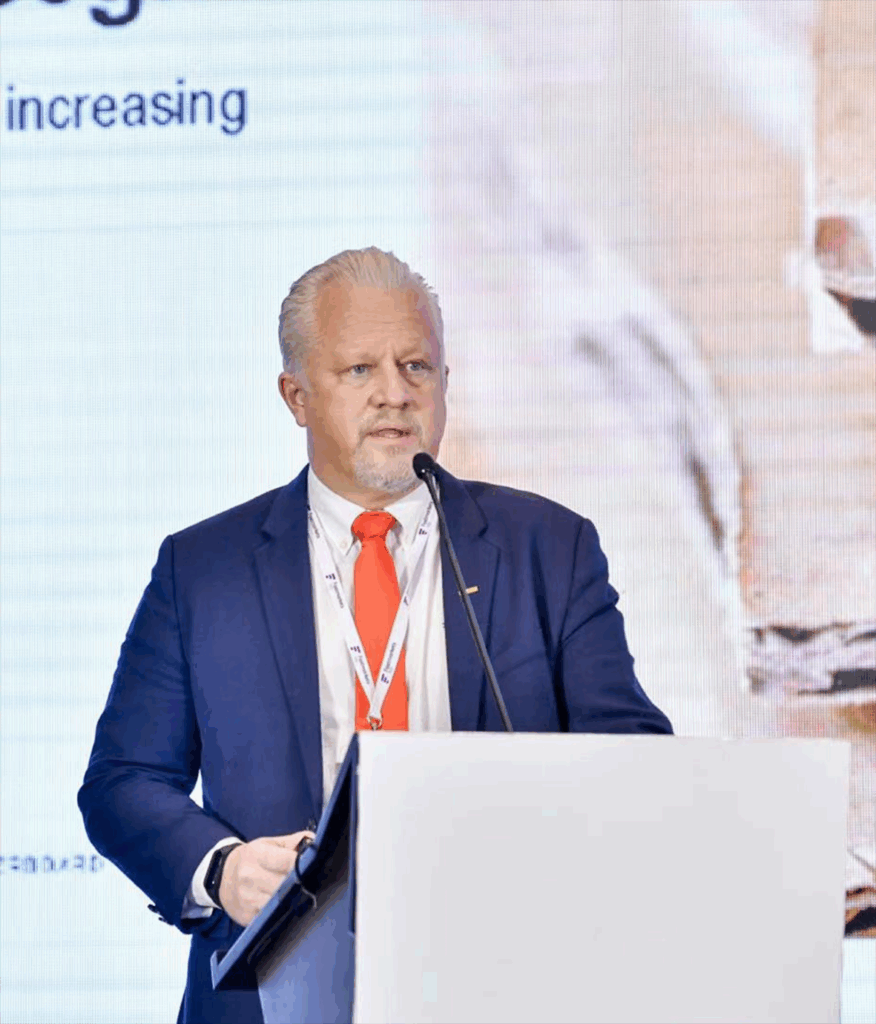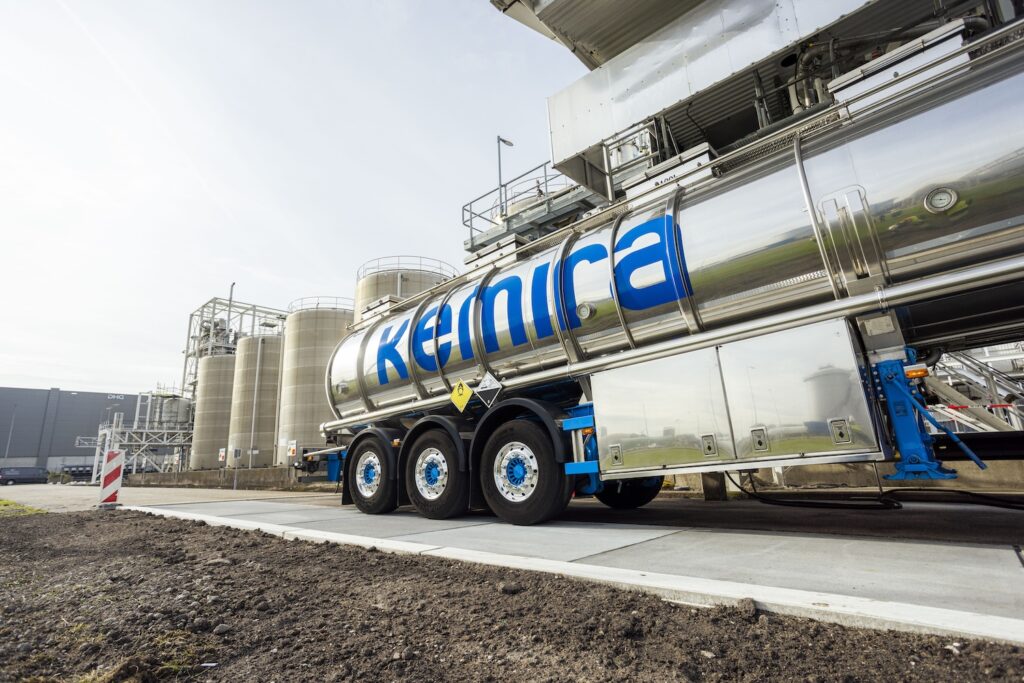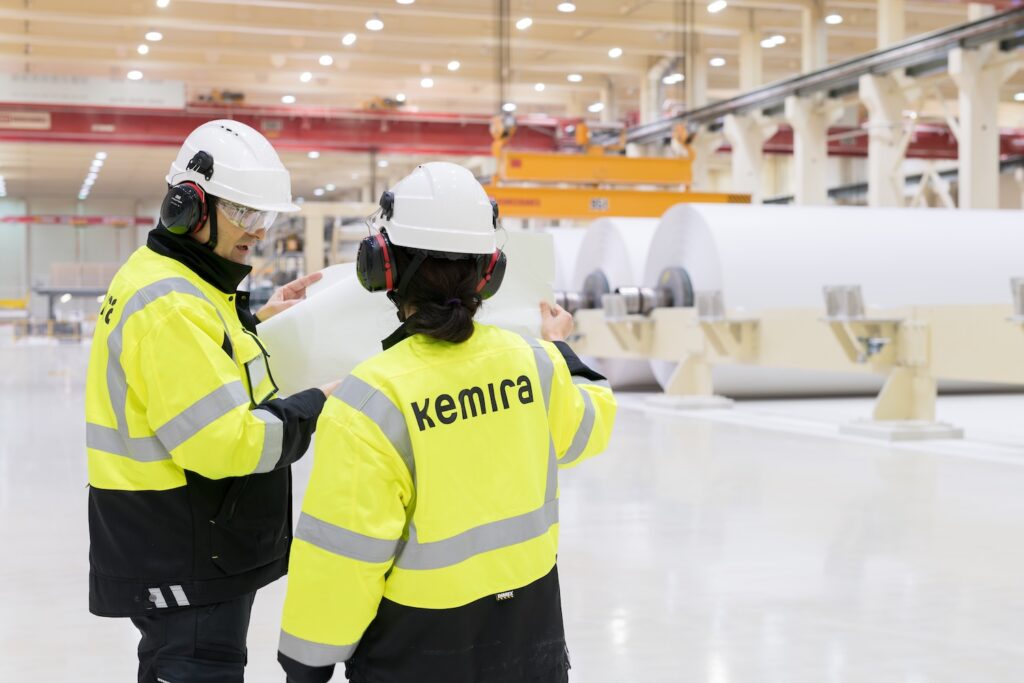Kemira Leads the Paper Industry with Chemistry Expertise, Strategic Positioning and Commitment to Sustainability
Kemira is one of the global leaders in sustainable chemical solutions for water-intensive industries. The company delivers tailored products and services to improve the product quality, processes and resource efficiency of its diverse range of customers. With its focus on water treatment, fibre and renewable solutions, Kemira enables the sustainability transformation of its customers. In 2024, Kemira reported annual revenue of EUR2.9 billion with a global team of some 4,700. Kemira is listed on the Nasdaq Helsinki.
paperASIA talked to Nichlas Kavander, Senior Vice President, Commercial, Packaging & Hygiene Solutions, Asia Pacific, Kemira recently on the company’s identity, role in the paper industry, its R&D and innovation updates, its views on sustainability and the company’s future direction. The interview highlights how Kemira integrates innovation, sustainability and strategy in the paper industry.

paperASIA: Kemira is often described as a global leader in sustainable chemical solutions for water‑intensive industries, especially pulp & paper. Could you elaborate on what distinguishes Kemira in the paper and board sector today?
Kavander: Kemira’s distinction in the paper industry stems from our unique combination of deep chemistry expertise, strategic market positioning and commitment to sustainability transformation. We’ve built our reputation over a century of chemistry innovation. Today we serve pulp, paper and fibre-based packaging industries as well as industrial and municipal water treatment in more than 100 countries. With 58 manufacturing sites globally and our position as the second-largest player in pulp and paper chemicals worldwide, we combine local proximity with global expertise. In the Asia Pacific region, we are present with 10 manufacturing sites. This approach ensures supply security and technical support that modern paper and board manufacturers need.
At the start of 2025, we restructured into three dedicated business units to better serve specific market demand. Our Packaging and Hygiene Solutions segment exemplifies this customer-centric approach, allowing us to be an even more dedicated partner to the rapidly growing fibre-based packaging and tissue markets. We’re a pioneer in renewable chemistry alternatives that support our customers’ sustainability goals and support the packaging value chain transition away from plastic and fossil-based solutions. We’ve also set ambitious climate targets covering our full value chain of operations, positioning us as a frontrunner in the industry. Additionally, our digital services development represents a significant differentiator, designed to unlock resource and cost efficiency gains and sustainability improvements for our customers.

paperASIA: How do recent capacity expansions—such as the Thailand plant for strength chemicals and past projects in South Korea (Ulsan) and China (Nanjing)—support your strategy in the APAC paper and board markets?
Kavander: Our recent expansions across Asia-Pacific directly reflect our continued commitment to serving the region’s dynamic growth with local manufacturing excellence and high-quality chemical products. The latest multimillion-euro investment at our Wellgrow site in Thailand is particularly strategic: we’re expanding multiple production lines for strength chemicals to specifically serve paper, board and tissue customers throughout Southeast Asia and India. When operational in August 2026, this will bring our total annual capacity there to approximately 100,000 tons.
This builds on our sustained capacity expansion across the region. In 2024, we expanded ASA sizing agent production at the Chinese Nanjing site, which is the world’s largest ASA production facility. High-quality ASA is the preferred choice for new paper and board machines and with the expansion, we responded to the increasing market demand. Earlier, in 2021, we opened a new dry polymer plant in Ulsan, South Korea, producing high-quality polyacrylamide products for retention, drainage, and water treatment applications, which are critical in modern paper and board manufacturing as well as in water treatment facilities.

These investments support our broader market approach. In 2024, we entered India with direct presence and established an office in Chennai. We’re very satisfied with our success and growth in India. Our regional footprint also includes regional R&D capabilities, including our Research & Innovation Center in Shanghai, China, ensuring we can develop solutions tailored to local market needs.
Our strategy has always been to position our manufacturing near our customers and maintain strong local technical expertise. This proximity allows us to better understand our customers’ challenges, respond more quickly to evolving market needs, and deliver world-class solutions reliably while ensuring supply security.


paperASIA: Can you share how the new organizational structure—especially the dedicated Research & Innovation unit and the New Ventures & Services group—has accelerated your innovation pipeline since it was started in January 2025?
Kavander: The organisational restructuring in January 2025 created three dedicated, customer-focused business units to serve the growing markets. Simultaneously, we strengthened our innovation capabilities and R&D approach to more effectively address both immediate market needs and long-term research opportunities. Product development sits close to customers across regions, allowing us to respond to evolving customer needs and increasing speed-to-market. Our three global Research & Innovation centers, including one in Shanghai for Asia Pacific, develop new products, concepts and technologies, with a dedicated Discovery function focusing on transformational innovations that address fundamental sustainability, circularity and material scarcity challenges. This approach gives us a robust development pipeline spanning several years, ensuring continuous innovation flow from breakthrough concepts to market-ready solutions.
The New Ventures & Services unit focuses on exploring, developing and commercialising new market arenas, technology platforms and digital service solutions across all our business units. A key focus is developing new-to-the-world renewable chemistries with our strategic partners, such as barrier solutions and other performance additives, to meet the growing demand for sustainable solutions as the packaging value chain shifts away from fossil-based materials. Another example of adjacent opportunities is our expansion into the textile industry, particularly cellulose-based textile fibres and textile recycling. There are fundamental similarities in these fibre-based applications to our traditional pulp and paper expertise, and our chemistry know-how can effectively address the process challenges these emerging markets face.
paperASIA: Kemira’s KemConnect™ Predictive Wet End service, uses machine learning to anticipate paper production disturbances. How is this digital transformation impacting customer operations?
Kavander: Our digital services for pulp and paper processes and water treatment build on decades of chemistry and application expertise. We’ve developed patented real-time monitoring and control technologies for chemistry applications over many years to help customers troubleshoot, optimise and continuously improve their processes. Today, with advanced analytics, machine learning, and AI technologies, we’ve moved beyond real-time visibility to predicting process disturbances before they occur.
The Predictive Wet End service exemplifies this approach by discovering wet-end disturbances and predicting runnability risks hours in advance based on the wet end chemistry status. This allows operators to make proactive adjustments before problems emerge and prevent issues that could impact paper machine runnability and end-product quality. The service, as all our KemConnect™ services, complements our chemical solutions, resulting in optimised chemical utilisation, reduced costs and improved performance.
Our philosophy is straightforward: through our digital solutions, we help customers optimise water and energy usage, reduce raw material consumption and waste and maintain uninterrupted production efficiency, supporting both their profitability and sustainability goals.
paperASIA: Could you describe some of your recent breakthroughs—such as biomass‑balanced wet strength resins or polysaccharide‑based renewable barrier coatings—and how they fit your sustainability and commercial ambitions?
Kavander: Our commitment to renewable solutions is reflected in our ambitious target of EUR500 million in revenue from renewable products by 2030. This also drives our innovation efforts across our customer industries. As packaging regulations tighten globally and consumer demand shifts more toward sustainable alternatives, our customers need chemistry partners to help them transition from fossil-based materials while maintaining performance and cost competitiveness. These mentioned solutions demonstrate different pathways in which we’re bringing renewable solutions to the market.
The biomass-balanced wet strength additives, launched in 2024 in Europe, are the latest addition to our pioneering biomass-balanced products portfolio, which we first launched in 2021 with polyacrylamides for water treatment and retention and drainage applications. With this approach, we can provide our customers with readily available renewable alternatives as genuine drop-in solutions. Our biomass-balanced products are certified according to ISCC PLUS standards and contain at minimum 50% renewable carbon through mass balance attribution. They maintain the same high quality and performance as standard products, while effectively reducing the use of fossil carbon in the value chain and the carbon footprint of the end product.
The plant-sugar based barrier coatings represent a breakthrough in renewable chemistry innovation, developed through our strategic partnership with IFF. We’ve been collaborating since 2020 to develop and commercialise sustainable biopolymers that can replace fossil-based equivalents in various applications. These alpha glucans combine biodegradability and material sustainability with high performance, enabling the development of competitive alternatives to fossil-based products. Kemira holds global exclusivity for commercialising these biopolymers in paper, board, and water treatment markets. Just recently, we formed a joint venture with IFF to start producing these renewable products on a commercial scale in late 2027.

paperASIA: Kemira has set ambitious targets for transitioning to renewable chemistries, aiming for over EUR500 million in revenue by 2030. What key strategies will drive this growth?
Kavander: Our EUR500 million renewable target reflects market demand. As our customers set their sustainability targets and commit to fully renewable end-products, they need fully renewable chemistries to achieve their goals. We’re driving this growth through three pathways for transforming our product portfolio.
Firstly, we convert current fossil-based products to renewable products by replacing raw materials and feedstocks. The biomass-balanced approach, which we already discussed, is a good example of this. It is a readily available and efficient way to reduce fossil carbon and increase renewable content in the value chain.
Second, we’re developing new products from renewable feedstocks that are readily available in the market, such as PHA (polyhydroxyalkanoates). In Asia Pacific, we recently announced our partnership with Bluepha to commercialise fully biobased barrier coatings. Introducing recyclable and biodegradable PHA in barrier coatings to paper, board, and molded fibre applications addresses the industry’s need to replace plastic and harmful PFAS compounds in packaging.
And third, we’re exploring breakthrough, new-to-the-world chemistries through strategic partnerships. Our collaboration with IFF on the alpha glucans represents this avenue, allowing us to bring new performance-competitive biopolymers to the market as alternatives to fossil-based products in various applications in paper and board packaging and water treatment.
paperASIA: Your sustainability objectives include significant cuts in Scope 1, 2 and 3 emissions, validated by the SBTi. How are these integrated into your innovation and operational planning?
Kavander: We are among the chemical industry forerunners with ambitious climate targets that are aligned with the Science-Based Targets initiative (SBTi) and validated by third parties. Our long-term ambition is to be carbon neutral by 2045, but we believe it’s critical to also focus on near-term climate action. For Scope 1 and 2 greenhouse gas emissions, we aim for a 52% reduction by the end of 2030, and for Scope 3 emissions, a 33% reduction by the end of 2033. A major area of focus is reducing our climate impact throughout our value chain. We’re for example sourcing clean energy and reducing transportation and logistics emissions. On the innovation side, we’re transforming our product portfolio by focusing on low-carbon footprint products and expanding our sustainable, renewable offering.
paperASIA: Kemira has initiated the Energy Efficiency Enhancement (E3Plus) program and the ENRE5 program in its aim to curb energy consumption. How do the programs help in achieving your carbon-neutral target by 2045?
These programmes directly support our carbon-neutral ambition and our other climate targets. Our business is energy-intensive so to mitigate our environmental impact, especially the impact on climate, we focus on improving our energy efficiency, reducing energy consumption, and transitioning our production sites to emission-free energy sources. Through the Energy Efficiency Enhancement programme, we aim to reduce our overall specific energy consumption, measured as kWh per metric ton of product. The additional ENRE5 program, launched in 2023, targets a 5% energy reduction at our coagulant and polymer manufacturing sites within three years, and with hundreds of projects identified, we’re on track to exceed the target.
paperASIA: Partnerships like the one with Metsä Group in 2023 aim to co‑develop fossil‑free raw materials by 2027. Can you discuss how such collaborations shape your sustainability roadmap?
Kavander: Our approach to sustainability transformation is fundamentally collaborative. Achieving truly renewable value chains requires strategic co-innovation both upstream and downstream with customers and partners. Reducing fossil dependence is a joint effort. Our key objective is to help our customers develop and achieve their environmental goals, while developing our sustainable product portfolio.
This partnership with Metsä is a practical example of this philosophy. As major industrial players, we’re well-positioned to reduce the environmental impacts of the forest industry value chain. By establishing a joint product development group, we can work toward both companies’ strategic goals and create solutions that deliver both environmental impact and commercial viability.
paperASIA: Looking ahead, what are your priorities in expanding the water chemicals business in the paper industry and tapping into adjacent markets like fibre-based textiles or digital services?
Kavander: Water treatment expertise is core to our business. Beyond pulp and paper, Kemira is serving industrial and municipal water treatment markets globally, and it represents a significant growth area for us. For the pulp and paper industry, we provide chemicals, application expertise, and digital services across all the key areas of water treatment, from raw water to wastewater treatment. This is becoming increasingly important as regulatory frameworks tighten, and mills face stricter environmental permits with tighter limits on wastewater discharge while simultaneously needing to reduce freshwater consumption. This creates demand for more efficient chemical solutions and optimised treatment processes, where our real-time and predictive digital services play a crucial role in helping customers improve efficiency, ensure compliance, and reduce costs.
As discussed, our digital services extend well beyond these water treatment applications, building on our chemistry expertise to support our customers’ process and resource efficiency across the entire papermaking process. We have KemConnect™ digital services from pulping to water treatment and for all key papermaking applications such as deposit control and strength to enable data-driven chemistry management and improve paper, board, and tissue machine runnability and cleanliness and product quality. We continue to develop these capabilities to provide our customers with predictive visibility and advisory that helps them achieve better overall performance, which also contributes to their sustainability goals.
Fibre-based textiles are an excellent example of an adjacent market where our chemistry expertise is increasingly needed as fibre-based economy advances, the shift away from fossil materials accelerates, and new fibre applications emerge. As we discussed earlier, both our cellulosic fibre chemistry and water treatment know-how can play a crucial role in helping both the man-made cellulosic fibre market as well as textile recycling address the process challenges they face. Similar opportunities exist in other emerging cellulose applications.



